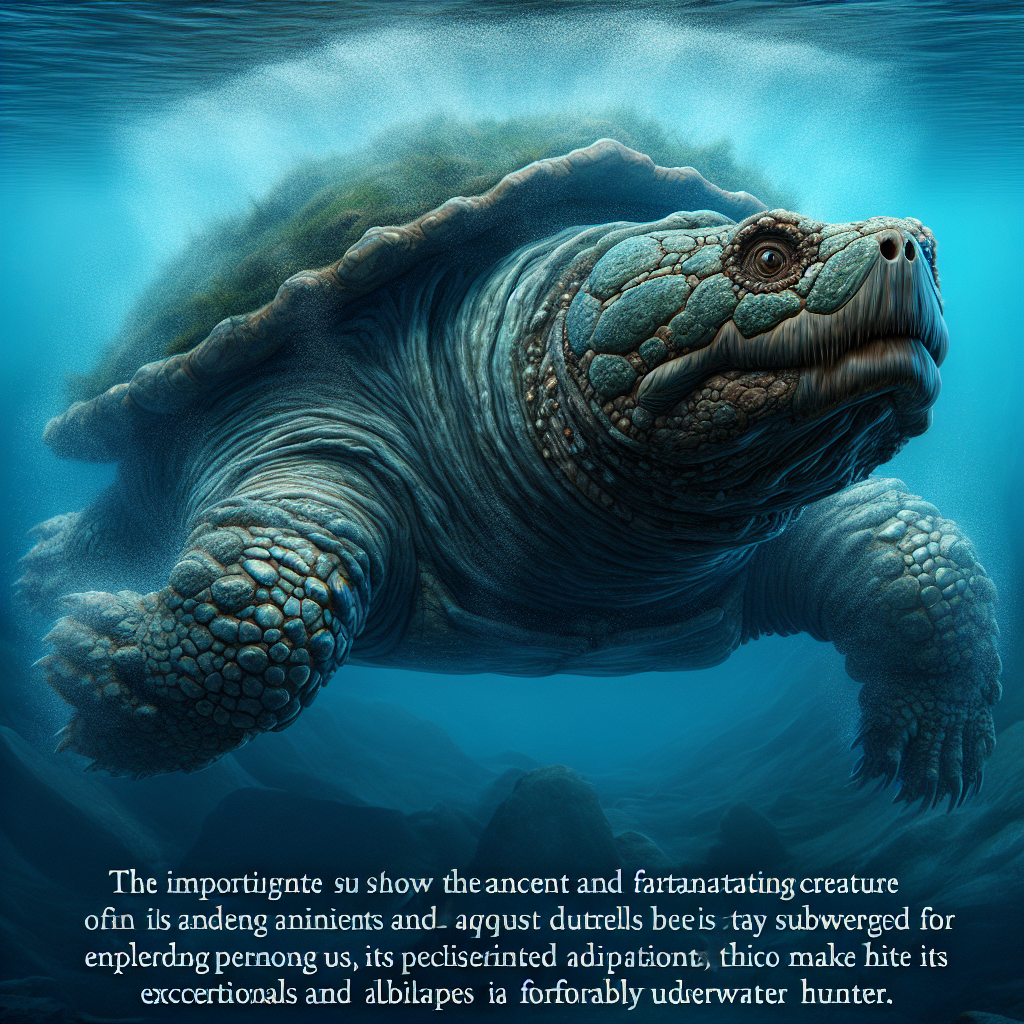Imagine you’re diving deep into the murky waters of a swamp, surrounded by the fascinating creatures that call it home. Among them is the alligator snapping turtle, a prehistoric-looking creature that strikes both fear and curiosity into the hearts of those who encounter it. Ever wondered just how long this impressive reptile can hold its breath underwater? In this article, we’ll explore the incredible breath-holding abilities of the alligator snapping turtle and uncover the secrets behind its aquatic prowess. Get ready to be amazed!

Physical characteristics of an alligator snapping turtle
Appearance
The alligator snapping turtle is an impressive creature with distinct physical characteristics. It has a large, muscular body covered in dark, rough-textured skin, often adorned with algae and other aquatic plants. Its head is large and triangular, resembling that of an alligator, with a hooked beak-like mouth. The shell, known as a carapace, is thick, heavy, and dark brown in color, providing ample protection from predators and the environment.
Size and weight
Alligator snapping turtles are known for their enormous size and weight. They are one of the largest freshwater turtles in the world, reaching lengths of up to three feet and weighing over 200 pounds. The males tend to be significantly larger than the females, showcasing their dominance and territorial behaviors.
Shell structure
The unique shell structure of the alligator snapping turtle is a key feature of its physical adaptation. The carapace is divided into three distinct ridges, giving it a rough and ridged appearance. These ridges provide camouflage, helping the turtle blend into its surroundings. Additionally, the shell has a hard exterior that offers protection against potential threats such as predators or falling debris.
Powerful jaws
One of the most remarkable physical characteristics of the alligator snapping turtle is its powerful jaws. Its beak-like mouth is equipped with a strong, hooked upper jaw that it uses to capture prey effectively. The lower jaw, on the other hand, contains a small, pink appendage known as a lure. This lure resembles a worm and is used to attract unsuspecting fish or other prey towards the turtle’s jaws. Once the prey gets close enough, the alligator snapping turtle strikes with lightning speed, securing its meal.
Aquatic adaptations
As an aquatic species, the alligator snapping turtle has evolved several adaptations that allow it to thrive in its watery habitat. Its feet are webbed, making it an excellent swimmer. In addition, the turtle is capable of closing its nostrils and valves in its throat, preventing water from entering its respiratory system while underwater. These adaptations enable the alligator snapping turtle to navigate its aquatic environment with ease and efficiency.
Respiratory system of an alligator snapping turtle
Breathing mechanism
Like other turtles, alligator snapping turtles have lungs for breathing air. However, their respiration is unique due to their ability to stay submerged for extended periods. When the turtle is underwater, it relies on stored oxygen and special adaptations to survive without access to fresh air.
Lung structure
The lungs of an alligator snapping turtle are relatively large compared to the size of their body. This allows them to store more oxygen during periods of breathing above the water’s surface. The lung structure is also designed to efficiently exchange gases, ensuring that the turtle can extract the maximum amount of oxygen from each breath taken.
Buoyancy control
Alligator snapping turtles have specialized adaptations that help them control their buoyancy while submerged. By adjusting the amount of air stored in their lungs and internal chambers, they can regulate their position in the water column. This allows them to float or sink as needed, conserving energy and prolonging their breath-holding ability.
Aquatic respiration
When underwater, alligator snapping turtles can rely on aquatic respiration as an alternative source of oxygen. This means that they can absorb oxygen directly from the water through specialized membranes in their mouth and cloaca. Though not as efficient as breathing air, this adaptation allows them to extend their breath-holding duration and survive in low-oxygen environments.
Factors affecting breath-holding duration
Age and size
The age and size of an alligator snapping turtle play a significant role in determining its breath-holding duration. Larger, older turtles generally have a higher capacity for holding their breath due to their larger lung size and greater oxygen storage capacity. Younger and smaller turtles may have shorter breath-holding durations as their respiratory systems are still developing.
Activity level
The activity level of an alligator snapping turtle can also impact its breath-holding duration. When the turtle is active and exerting a greater amount of energy, its oxygen consumption increases, shortening the time it can hold its breath. Conversely, a more relaxed and sedentary turtle conserves energy and can hold its breath for longer periods of time.
Water temperature
Water temperature is another factor that affects the breath-holding duration of alligator snapping turtles. Cold water reduces the metabolic rate of the turtle, slowing down oxygen consumption and allowing it to hold its breath for longer periods. In contrast, warm water increases the turtle’s metabolic rate, shortening its breath-holding duration.
Oxygen levels
The availability of oxygen in the surrounding water directly affects the breath-holding capacity of alligator snapping turtles. In low-oxygen environments, such as stagnant or polluted water bodies, the turtle’s breath-holding duration may be considerably shorter. These turtles have adaptations that help them survive in such conditions, but their overall oxygen supply is limited.
Stress and fear
Alligator snapping turtles are sensitive to stress and fear, which can impact their breath-holding duration. When subjected to stressful situations, such as encounters with predators or disturbances caused by human activity, the turtle’s heart rate increases, resulting in a higher oxygen consumption rate. This increased oxygen demand reduces the duration for which the turtle can hold its breath.
Scientific studies on breath-holding abilities
Research methodologies
Scientific studies have been conducted to gain insights into the breath-holding abilities of alligator snapping turtles. These studies employ various methodologies to measure and observe the turtles’ behavior and physiological responses during breath-holding periods.
Duration experiments in controlled environments
Researchers have conducted experiments in controlled environments to measure the maximum breath-holding duration of alligator snapping turtles. These experiments involve placing the turtles in containers filled with water and monitoring their behavior and vital signs until they resurface to breathe.
Observations in the wild
Observations of alligator snapping turtles in their natural habitat have also provided valuable data on their breath-holding abilities. Researchers monitor the turtles and record their behavior and surfacing patterns to understand how long they can remain submerged in different environmental conditions.
Comparison with other turtle species
Scientific studies have also involved comparing the breath-holding abilities of alligator snapping turtles with those of other turtle species. This comparative approach helps to understand the unique physiological adaptations and capabilities of alligator snapping turtles in relation to their counterparts.

Average breath-holding duration in alligator snapping turtles
Findings from research studies
Research studies indicate that alligator snapping turtles can hold their breath for impressive durations. On average, adult turtles can remain submerged for 40 to 50 minutes before resurfacing to breathe. However, some individuals have been observed holding their breath for over an hour, showcasing the incredible breath-holding capacity of these turtles.
Variability among individuals
It is important to note that there is variability among individuals when it comes to breath-holding duration. Factors such as size, age, and overall health of the turtle can influence how long it can stay submerged. Additionally, individual behaviors and habits may impact breath-holding abilities, resulting in variations within the species.
Impact of environmental factors
The breath-holding duration of alligator snapping turtles is heavily influenced by environmental factors. As mentioned earlier, water temperature, oxygen levels, and stress levels can significantly affect how long the turtles can hold their breath. Understanding these environmental influences is crucial in managing and conserving their populations effectively.
Potential dangerous situations
While alligator snapping turtles have impressive breath-holding abilities, there are situations where extended submersion may prove fatal. For example, if turtles become trapped in submerged nets or debris, their prolonged breath-holding capability may not be sufficient for survival. It is essential to consider their vulnerability in such circumstances and take appropriate conservation measures.
Signs of breath-holding in alligator snapping turtles
Behavioral cues
Observing the behavior of alligator snapping turtles can provide clues about their breath-holding status. If a turtle is diving repeatedly and staying underwater for prolonged periods, it is likely holding its breath. The absence of surfacing and rapid movements may indicate that the turtle is conserving energy and maximizing its breath-holding duration.
Physical signs
Physical signs can also indicate that an alligator snapping turtle is holding its breath. These signs include the absence of bubbles or air escaping from the nose or mouth while submerged. Additionally, a relaxed body posture and extended periods of stillness can suggest that the turtle is conserving oxygen and holding its breath.
Post-breath resurfacing behavior
After resurfacing to breathe, alligator snapping turtles may exhibit specific behaviors that indicate they were holding their breath. These behaviors can include loud exhaling sounds and forceful expelling of water from their nostrils and mouth. These actions help the turtle clear any water that may have entered its respiratory system during prolonged submersion.
Physiological adaptations for extended submersion
Reduced metabolic rate
Alligator snapping turtles have the remarkable ability to lower their metabolic rate, enabling them to conserve energy and survive for extended periods without fresh oxygen. This reduction in metabolic activity reduces the overall oxygen demand of the turtle’s body, allowing it to hold its breath for extended periods.
Anaerobic respiration
During extended breath-holding periods, alligator snapping turtles switch from aerobic respiration (using oxygen) to anaerobic respiration (not using oxygen). This anaerobic respiration allows them to generate small amounts of energy without consuming additional oxygen. However, relying solely on anaerobic respiration is not sustainable for extended periods, and the turtle must resurface to replenish its oxygen supply.
Blood distribution and oxygen storage
Alligator snapping turtles have specialized adaptations in their circulatory system that aid in extended breath-holding. They can redirect blood flow away from non-essential organs to the heart and brain, ensuring that these vital organs receive the maximum oxygen supply during submersion. Additionally, the turtle’s body can store oxygen within its muscles and tissues, providing a backup source during breath-holding.
Muscle and organ adaptations
The muscle and organs of alligator snapping turtles have adaptations that allow them to withstand the physiological stress of extended submersion. These tissues have increased tolerance to low oxygen levels, reduced build-up of metabolic waste products, and enhanced cell survival mechanisms. These adaptations enable the turtle to function efficiently during breath-holding periods and recover quickly upon resurfacing.
Behavioral strategies for prolonged breath-holding
Lung deflation
Alligator snapping turtles employ a behavioral strategy known as lung deflation to increase their breath-holding duration. Before submerging, the turtle can expel air from its lungs, reducing buoyancy and allowing it to sink more easily. This lung deflation conserves energy by requiring fewer movements to stay submerged and extends the overall breath-holding capacity.
Reduced activity levels
When alligator snapping turtles anticipate the need for extended breath-holding, they often reduce their activity levels. By minimizing movements and conserving energy, the turtle can prolong its breath-holding duration. This behavior is commonly observed during periods of hibernation or when the turtle is in a low-energy state.
Buried hibernation
During winter months, alligator snapping turtles enter a state of hibernation, burying themselves in the mud at the bottom of bodies of water. This behavior allows them to conserve energy and reduce their oxygen requirements further. By slowing down their metabolic rate and becoming partially dormant, the turtles can survive for months without resurfacing to breathe.
Camouflaging techniques
To avoid detection and predation, alligator snapping turtles often employ various camouflaging techniques during breath-holding periods. They may bury themselves in mud, conceal themselves under vegetation, or utilize their algae-covered shells to blend in with their surroundings. By remaining inconspicuous, the turtle reduces the risk of attracting attention while holding its breath.
Implications for conservation and ecological role
Role in aquatic ecosystems
Alligator snapping turtles play a vital ecological role in their native habitats. As apex predators, they help regulate populations of fish and other aquatic organisms, contributing to the overall health and balance of aquatic ecosystems. By maintaining a healthy population of these turtles, we can ensure the preservation of these delicate ecosystems.
Survival strategies
Understanding the breath-holding abilities and adaptations of alligator snapping turtles is crucial for their survival. By identifying key environmental factors that impact their breath-holding duration, conservation efforts can be tailored to ensure optimal conditions for their well-being. Protecting their habitats, maintaining water quality, and minimizing environmental stressors are necessary steps to safeguard their populations.
Conservation efforts
Alligator snapping turtles are considered a threatened species, primarily due to habitat loss, pollution, and overharvesting. Conservation efforts focus on protecting their natural habitats, implementing regulations to prevent illegal trade, and raising awareness about the importance of these magnificent creatures. By engaging in conservation initiatives, we can contribute to the preservation of alligator snapping turtles for future generations to appreciate and enjoy.
Illegal wildlife trade
Unfortunately, alligator snapping turtles are highly sought after in the illegal wildlife trade. Due to their impressive size and unique appearance, they are often captured for their meat, shells, or as exotic pets. This illegal trade poses a grave threat to their populations and undermines conservation efforts. It is essential to combat illegal wildlife trade through stringent regulations, public education, and active enforcement to safeguard these turtles from exploitation.
Tips for observing alligator snapping turtle behavior
Safety precautions
Observing alligator snapping turtles in their natural habitat requires taking appropriate safety precautions. These turtles have powerful jaws and can deliver a severe bite if threatened or mishandled. It is important to maintain a safe distance, avoid direct contact, and respect their space to ensure both human safety and the well-being of the turtles.
Best observation locations
Alligator snapping turtles are predominantly found in freshwater habitats, including rivers, lakes, and swamps. To observe their behavior, it is recommended to visit suitable habitats, ideally those with a healthy turtle population. Consulting with local conservation organizations, naturalists, or park authorities can provide valuable information on the best observation sites in your area.
Cues to look for
When observing alligator snapping turtles, there are several cues to look for that may indicate their presence. These include the sight of their large, dark shells protruding above the water’s surface, their snouts breaking through the water to breathe, and their characteristic lure-like appendage. Being patient and observant will increase the chances of witnessing their fascinating behavior.
Responsible wildlife viewing
Responsible wildlife viewing is crucial when observing alligator snapping turtles and other wildlife. It is important to remember that these animals are wild and should be respected as such. Avoid disturbing their natural behavior or habitat, maintain a safe distance, and refrain from making excessive noise or sudden movements that could startle or stress the turtles. By being considerate observers, we can minimize our impact on their environment and ensure the turtles’ well-being.
In conclusion, the alligator snapping turtle is an extraordinary creature with unique physical characteristics and remarkable breath-holding abilities. Its appearance, size, shell structure, powerful jaws, and aquatic adaptations make it a formidable predator in freshwater ecosystems. Understanding their respiratory system, the factors affecting their breath-holding duration, and their physiological and behavioral adaptations provides insights into their survival strategies. By appreciating their ecological role, supporting conservation efforts, and responsibly observing their behavior, we can contribute to the protection and preservation of these fascinating turtles for generations to come.
